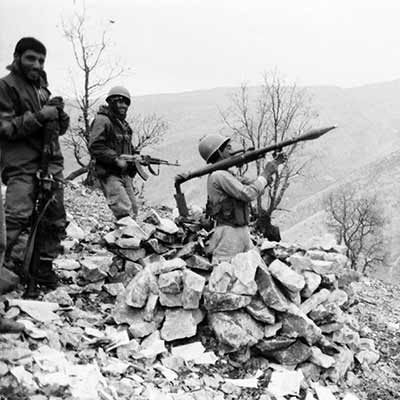Battles
Operation Nasr 5
Fatemeh Kasiri
190 Views
The Islamic Revolutionary Guard Corps (IRGC) Ground Forces launched Operation Nasr 5 in June 1987 in the western part of Sardasht, by employing specialized mountain warfare tactics.
Beginning in early 1987, the IRGC opened a new front against the Iraqi army in northwestern Iran not only to capture strategic highlands and gain the military upper hand but also to block infiltration routes used by anti-revolutionary groups and “Jash” forces (Kurdish collaborators with the Iraqi regime). The operation also aimed to facilitate the movement of Iraqi Kurdish opposition forces—under the command of Ramazan Headquarters—from deep inside Iraq territory to the Iranian border, allowing Iran to provide greater logistical and military support to these groups. The anti-revolutionaries used these areas in which there were mountains, hills, and steep slopes for their operations. On June 11, 1987, a coordination meeting was held to assess the military readiness of the engaging headquarters, discuss the existing challenges, and finalize tactical plans. Muhammad Ali (Aziz) Jafari, commander of Quds Headquarters, and Seyyed Yahya (Rahim) Safavi, deputy commander of the IRGC Ground Forces attended the meeting.[1]
Operation Nasr 5 was carried out on Kaleqandi Heights, Ferferi Peak, and its surrounding areas. Ferferi Peak overlooked a relatively broad plain, with the Iraqi town of Qalat Dizeh located to its northwest. The area between Iranian and Iraqi lines was known as the Bujar Plain. The whole area was located along the borders of West Azerbaijan and Kurdistan provinces. Controlling the Ferferi Peak and its surroundings allowed clear surveillance and tactical dominance over both Iraqi and Iranian positions.[2] Due to the mountainous nature of the area, resupplying forces stationed on the heights was extremely difficult. Each round trip on foot from the last base to Ferferi Peak took around five hours. Consequently, the engineering corps of the 8th Najaf Ashraf Division began building roads ten days before the start of the operation.
On June 16, 1987, the IRGC Commander-in-Chief Mohsen Rezaei formally assigned the mission to the IRGC Ground Forces. The plan was to deploy Najaf Ashraf Headquarters and Quds Headquarters to the Mawat and Sardasht respectively to execute Operation Nasr 5.[3]
Therefore, the IRGC Ground Force operation began at 12:15 AM on Monday, June 22, 1987, with the code-name “Ya Zahra (s)” in southwestern Sardasht, West Azerbaijan Province.[4] It took the Iranian forces only two hours to seize the Kaleqandi and Ferferi heights. However, IRGC forces faced heavy resistance by Iraqi troops at the Kaleqandi Ridge and many of them were martyred. Likewise, some members of the Jahad-e Sazandegi Organization, who had been working on road construction got injured thereby the construction projects were halted.
Following the initial progress, Aziz Jafari and Ahmad Kazemi realized that there is a connecting ridge between Kaleqandi and Ferferi. It hosted five Iraqi positions, the most important of which was the “Qoleh Sangi” Base. This could seriously endanger the success of the entire operation. Therefore, it was decided that the 8th Najaf Ashraf Division seize this ridge the following night, using some forces of the Imam Reza (as) Battalion. Once the decision was finalized, the battalion and company commanders began reconnaissance and planning for the operation.[5]
On June 23rd, the Imam Reza (as) Battalion, comprising six squads (approximately 150 troops), moved towards the designated area to capture the connecting ridge between Ferferi and Kaleqandi heights. The main attack was going to be launched on three primary fronts (the Kaleqandi side) and a diversionary one (from the Ferferi direction). Although all units reached their positions on time, one group encountered an Iraqi ambush, delaying the execution of the operation. The military engagement began at 10:30 PM, and despite heavy Iraqi fire, Iranian forces pressed on. Accurate fire support from Iranian forces enabled them to achieve their objectives before dawn. Then, Jahad-e Sazandegi Organization teams moved in to resume construction work.
As a result of this operation, the Bujar Plain and several Iranian villages that had been under direct Iraqi fire were liberated. Iranian forces also secured control over the border region.[6] Taking control of the mountains and heights overlooking Qaleh Dizeh in Iraqi Kurdistan (east of Erbil and north of Sulaymaniyah), nineteen Iraqi villages came within Iranian surveillance. Furthermore, twenty kilometers of the border fell under the IRGC control. A mechanized company, an infantry battalion of the 97th Brigade of the 24th Division, and a battalion of Jash forces were destroyed. Anti-revolutionary infiltration routes in the Bujar Plain were also sealed off.[7]
At 1:30 AM on July 29, 1987, the Iraqi army launched a heavy counterattack, regaining part of the connecting ridge.[8] However, the Iranian forces, led by Ahmad Kazemi and supported by mortar fire and several tanks of the 27th Muhammad Rasulullah (pbuh) Division, halted the Iraqi advance.[9] During the operation, dozens of Iraqi soldiers were killed or wounded, and around one hundred were captured by Iranian forces.[10]
[1] Lotfollahzadegan, Alireza. Rouzshomare Jang-e Iran va Araq, Ketab-e Chehel-o-nohom: Tasvib-e Qatnameh 598 (Chronology of the Iran-Iraq War, Volume 49: Adoption of Resolution 598), Tehran: Markaz-e Asnad va Tahqiqat-e Defa-e Muqaddas-e Sepah-e Pasdaran-e Enqelab-e Eslami, 2008, Pp. 24 and 138.
[2] Ibid., p. 256.
[3] Ibid., Pp. 191 and 278.
[4] Samiei, Ali. Karnam-e Tawsifi-ye Amaliyat-e Razmandegan-e Eslam dar Tool-e Hasht Saal-e Defa-e Muqaddas (Descriptive Report of the Operations of Islamic Combatants during the Eight Years of Sacred Defense), Tehran: Moavenat-e Tablighat va Entesharat-e Namayandegi-ye Vali-e Faqih dar Niroo-ye Zamini, 1997, p. 345; Lotfollahzadegan, Alireza. Rouzshomare Jang-e Iran va Araq, Ketab-e Chehel-o-nohom (Chronology of the Iran-Iraq War, Volume 49), p. 278.
[5] Lotfollahzadegan, Alireza. Rouzshomare Jang-e Iran va Araq, Ketab-e Chehel-o-nohom (Chronology of the Iran-Iraq War, Volume 49), p. 278.
[6] Ibid., Pp. 288–289.
[7] Samiei, Ali. Karnam-e Tawsifi-ye Amaliyat-e Razmandegan-e Eslam dar Tool-e Hasht Saal-e Defa-e Muqaddas (Descriptive Report of the Operations of Islamic Combatants during the Eight Years of Sacred Defense), p. 289.
[8] Lotfollahzadegan, Alireza. Rouzshomare Jang-e Iran va Araq, Ketab-e Chehel-o-nohom (Chronology of the Iran-Iraq War, Volume 49), p. 372.
[9] Ibid., p. 301.
[10] Ibid., p. 289.





